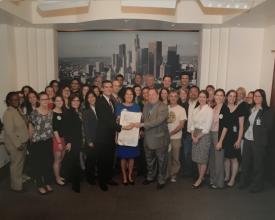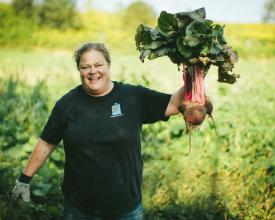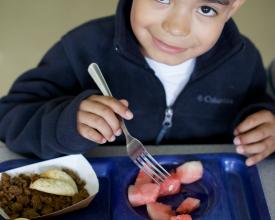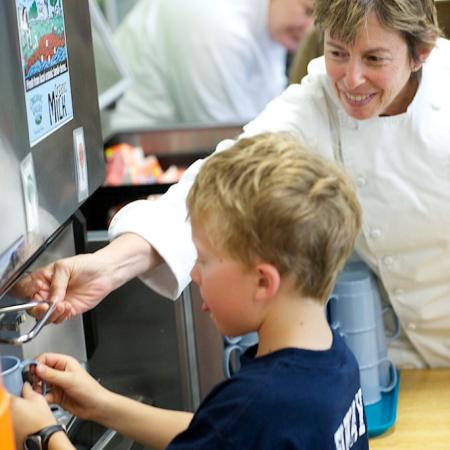
Good Food Purchasing Program (GFFP)
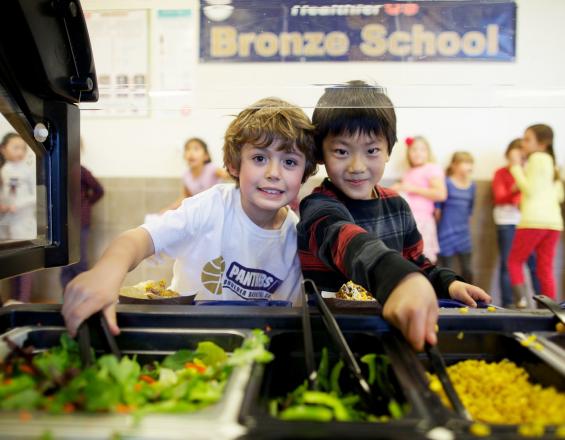
Adopted first by the City of Los Angeles in 2012, the Good Food Purchasing Programme achieved that in L.A. institutions, which serve about 750,000 meals a day, children get more local, sustainable, fair and humanely produced food to eat. The Programme has set off a nationwide movement and inspired the creation of the Center for Good Food Purchasing, which is now promoting the programme across the United States. By now 27 public institutions in 14 U.S. cities are enrolled. Due to its impressive achievements and fast roll-out thoughout the country, the Good Food Purchasing Program was recognized with an Honourable Mention of the 2018 Future Policy Award, awarded by the World Future Council in partnership with FAO and IFOAM – Organics International.
Context
Challenges addressed
California is the world’s fifth largest supplier of food, cotton fibre, and other agricultural commodities, and the largest producer of food (by dollar volume) in the United States. The Greater Los Angeles Area is the nation’s second-most populous urban region, with 18.7 million residents. To address unsustainable food systems, in September 2009, the Mayor of Los Angeles Antonio Villaraigosa announced the creation of the Los Angeles Food Policy Task Force, which was charged with developing a Good Food policy agenda for Los Angeles. In 2011, the LAFPC Working Group ‘Build a Market for Good Food’ developed the Good Food Purchasing Guidelines for Food Service Institutions, in collaboration with local and national experts in relevant fields. In 2012, Mayor Villaraigosa issued an executive directive impacting all city departments that purchased over $10,000 of food, also supported by the Los Angeles City Council.
Location
Process
Summary of the process
By setting the right Objectives (BB1) and through a broad stakeholder consultation, the Good Food Purchsaing Program was designed, Using a metric-based flexible framework for implementation (BB2). The design and success of its implementation in Los Angeles and by Los Angeles Unified School District build its Potential as a Transferable Model (BB3) and kicked off a nationwide movement.
Building Blocks
Objectives
Adopted first by the City of Los Angeles in 2012, the Good Food Purchasing Program ® creates a transparent supply chain and helps institutions to measure and then make shifts in their food purchases.
Its objectives are:
- To harness the purchasing power of major institutions to encourage greater production of sustainably produced food, healthy eating, respect for workers’ rights, humane treatment of animals and support for the local small business economy.
- To shift as many dollars as possible towards Good Food in order to achieve an economy of scale.
Enabling factors
It is the first procurement model to support five food system values – local economies, environmental sustainability, valued workforce, animal welfare and nutrition – in equal measure and thereby encourages myriad organizations to come together to engage for shared goals.
Lesson learned
Within just six years, the Good Food Purchasing Program has achieved remarkable impact.
The Good Food Purchasing Program has set off a nationwide movement to establish similar policies in localities small and large, and inspired the creation of the Center for Good Food Purchasing.
Using a metric-based flexible framework for implementation
The Good Food Purchasing Program’s metric-based, flexible framework encourages large public institutions to measure and then make shifts in their food purchases. By adopting the framework, food service institutions commit to improving their regional food system by implementing meaningful purchasing standards in all five value categories:
- Local Economics: the Good Food Purchasing Program supports local small and mid-sized agricultural and food processing operations.
- Environmental Sustainability: the Good Food Purchasing Progam requires institutions to source at least 15% of the food from producers that employ sustainable production systems.
- Valued Workforce: the Good Food Purchasing Policy promotes safe and healthy working conditions and fair compensation for all food chain workers and producers.
- Animal Welfare: the Good Food Purchasing Policy promotes healthy and humane care for farm animals.
- Nutrition: Finally, the Good Food Purchasing Policy promotes health and well-being by outlining best practices that offer generous portions of vegetables, fruit, whole grains and minimally processed foods, while reducing salt, added sugars, saturated fats, and red meat consumption, and eliminating artificial additives.
Enabling factors
The Good Food Purchasing Program is nationally regarded as the most comprehensive and metric-based food procurement policy in the country. Verification, scoring and recognition are central components. When an institution enrolls in the Good Food Purchasing Program, staff of the Center for Good Food Purchasing work with them to collect in depth information about purchasing and food service practices.
Lesson learned
To become a Good Food Provider, the food service institution has to at least meet the baseline (equal to one point) in each of the five values. Meeting even higher standards results in more points being awarded. The accumulation of points across all values is used to calculate and award a star rating. The baseline and higher standard purchasing criteria are set out in the Good Food Purchasing Standards, which are updated every five years, most recently in September 2017. There are five status levels of a Good Food Purchaser (1-5 Stars) that correspond to a respective range of points. In order to achieve a 5 Star level, the institution must achieve 25 or more points. As of June 2018, five out of 27 institutions have achieved a star rating, amongst them Boulder Valley School District that achieved 5 Stars in 2017 and Oakland Unified School District that achieved 4 Stars in 2016. After one year, purchasers are expected to increase the amount of Good Food that they purchase.
Potential as a Transferable Model
L.A. City Departments and LAUSD set an example that has since influenced many other areas in the United States. The notable success of the Good Food Purchasing Program in 2012 led to a substantial number of requests for technical assistance from other cities and food policy councils looking to implement similar strategies. Indeed the Program has set off a nationwide movement to adopt the Program standards in localities small and large. This led to the development of the Center for Good Food Purchasing in 2015, a NGO which now owns and manages the programme, as well as its expansion across the United States. By now 27 public institutions in 14 U.S. cities are enrolled, which collectively spend nearly USD 895 million on food each year.
Enabling factors
The Program is adaptable to specific contexts and such adaptations have been used to further advance agroecology, e.g. in Cook County. According to the Center’s staff, the Good Food Purchasing Program could be applied anywhere, including in low-income countries.
Lesson learned
As of 2018, several other cities (San Francisco, CA; Oakland, CA; Chicago, IL; Cook County, IL) have adopted the Good Food Purchasing Program and campaigns are underway in many additional cities (Austin, TX; Chicago, IL; Cincinnati, OH; Madison, WI; Minneapolis/St. Paul, MN; New York; Washington, D.C.; and Baltimore) to push for its adoption.
The Good Food Purchasing Program has encouraged elected and governmental officials to re-examine how they can use public budgets to better serve their community. That fundamental shift in thinking will produce important positive results for years to come.
Impacts
Since 2012, the Good Food Purchasing Program has made a difference in all Los Angeles City Departments and LAUSD that serve together approximately 750,000 meals a day. The extent of its influence on food supply chains can be best examined by focusing on the most prominent example, the LAUSD serving over 600,000 students. The Good Food Purchasing Program increased considerably LAUSD’s purchase of sustainable local products. In the first year of enrolment the LAUSD went from less than 10% local sourcing of produce, to an average of 60% local produce, redirecting USD 12 million to support more sustainable production and avoiding long transport routes. As a result, 150 new well-paid food chain jobs were created in L.A. County, including food processing, manufacturing and distribution. In another example, LAUSD’s bread distributor had been sourcing out-of-state wheat for its USD 45-55 million annual servings of rolls, but today, most of the L.A. school district’s rolls are made from wheat grown on 44 Food Alliance-certified farms in California, milled in downtown L.A., and prices have stayed the same over the last three years. These impacts extend beyond LAUSD as Gold Star Foods now distributes these same products to over 550 schools across the western United States.
Beneficiaries
Beneficiaries are vulnerable groups such as school children, patients, the elderly as well as local small and mid-sized farms and food processing operations and their workers.
Sustainable Development Goals
Story

By Ann Cooper, Chef at Boulder Valley School District, which was the first to receive a five star rating from the Good Food Purchasing Programme:
Boulder Valley School District (BVSD)’s designation as the highest ranking Good Food Provider proves it’s possible for school districts with limited budgets to not only excel, but lead the way, in building a food system based on the Program’s values without increasing food costs. Through local food purchasing, BVSD invested $890,700 into the Colorado economy—over 41 percent of its total food spend, which impacts over 2.19 million meals per school year. Almost 10 percent of these purchases came from small, local farms within 200 miles of the school district.
As Chef Ann Cooper notes, it’s these regional producers that help the district meet goals across the five Good Food Purchasing values: “It’s really hard to pick just one or two [local producers to recognize].” Chef Ann extended her gratitude and compliments to heritage meat producers, a small local tamale company, a broker who helps small growers aggregate products so they can sell to the district, and “nine farmers [who] are excellent partners in Good Food because not only do they provide us with the highest quality produce, but we collaborate with them to provide educational opportunities to our students, both in cafeterias and on the farms. Our farmers work hard every day to ensure that our community has access to the most nutritious foods while practicing environmentally sustainable agriculture and supporting the staff with fair, livable wages.”
Chef Ann also highlights the important role the district can have in providing some level of certainty to farmers, even as weather threatens to devastate harvests: “Right now I’m most inspired by our ability to support local farmers, even when Mother Nature is fighting against them, as happened with several hail storms this year. Even when some of the produce is damaged, and perhaps not sellable at market, we can purchase those items in large quantities to help our farmers stay in business. And when we pair that with being able to feed kids delicious, healthy food, it’s a win-win for us.”


